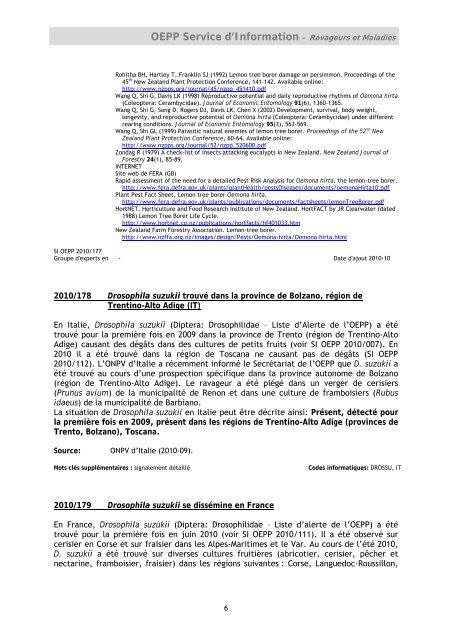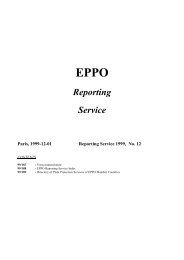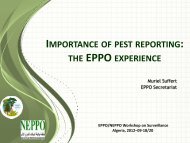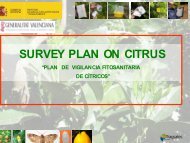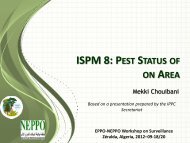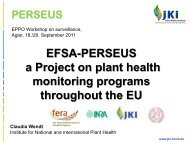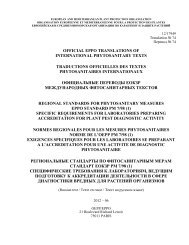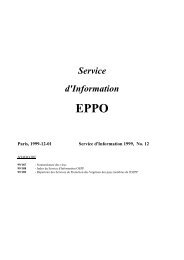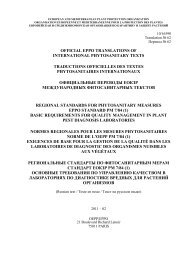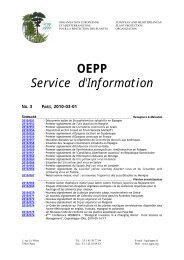archives.eppo.org - Lists of EPPO Standards - European and ...
archives.eppo.org - Lists of EPPO Standards - European and ...
archives.eppo.org - Lists of EPPO Standards - European and ...
You also want an ePaper? Increase the reach of your titles
YUMPU automatically turns print PDFs into web optimized ePapers that Google loves.
OEPP Service d’Information – Ravageurs et Maladies<br />
Rohitha BH, Hartley T, Franklin SJ (1992) Lemon tree borer damage on persimmon. Proceedings <strong>of</strong> the<br />
45 th New Zeal<strong>and</strong> Plant Protection Conference, 141-142. Available online:<br />
http://www.nzpps.<strong>org</strong>/journal/45/nzpp_451410.pdf<br />
Wang Q, Shi G, Davis LK (1998) Reproductive potential <strong>and</strong> daily reproductive rhythms <strong>of</strong> Oemona hirta<br />
(Coleoptera: Cerambycidae). Journal <strong>of</strong> Economic Entomology 91(6), 1360-1365.<br />
Wang Q, Shi G, Song D, Rogers DJ, Davis LK, Chen X (2002) Development, survival, body weight,<br />
longevity, <strong>and</strong> reproductive potential <strong>of</strong> Oemona hirta (Coleoptera: Cerambycidae) under different<br />
rearing conditions. Journal <strong>of</strong> Economic Entomology 95(3), 563-569.<br />
Wang Q, Shi GL (1999) Parasitic natural enemies <strong>of</strong> lemon tree borer. Proceedings <strong>of</strong> the 52 nd New<br />
Zeal<strong>and</strong> Plant Protection Conference, 60-64. Available online:<br />
http://www.nzpps.<strong>org</strong>/journal/52/nzpp_520600.pdf<br />
Zondag R (1979) A check-list <strong>of</strong> insects attacking eucalypts in New Zeal<strong>and</strong>. New Zeal<strong>and</strong> Journal <strong>of</strong><br />
Forestry 24(1), 85-89.<br />
INTERNET<br />
Site web de FERA (GB)<br />
Rapid assessment <strong>of</strong> the need for a detailed Pest Risk Analysis for Oemona hirta, the lemon-tree borer.<br />
http://www.fera.defra.gov.uk/plants/plantHealth/pestsDiseases/documents/oemonaHirta10.pdf<br />
Plant Pest Fact Sheet. Lemon tree borer Oemona hirta.<br />
http://www.fera.defra.gov.uk/plants/publications/documents/factsheets/lemonTreeBorer.pdf<br />
HortNET. Horticulture <strong>and</strong> Food Research Institute <strong>of</strong> New Zeal<strong>and</strong>. HortFACT by JR Clearwater (dated<br />
1988) Lemon Tree Borer Life Cycle.<br />
http://www.hortnet.co.nz/publications/hortfacts/hf401033.htm<br />
New Zeal<strong>and</strong> Farm Forestry Association. Lemon-tree borer.<br />
http://www.nzffa.<strong>org</strong>.nz/images/design/Pests/Oemona-hirta/Oemona-hirta.html<br />
SI OEPP 2010/177<br />
Groupe d'experts en - Date d'ajout 2010-10<br />
2010/178 Drosophila suzukii trouvé dans la province de Bolzano, région de<br />
Trentino-Alto Adige (IT)<br />
En Italie, Drosophila suzukii (Diptera: Drosophilidae – Liste d’Alerte de l’OEPP) a été<br />
trouvé pour la première fois en 2009 dans la province de Trento (région de Trentino-Alto<br />
Adige) causant des dégâts dans des cultures de petits fruits (voir SI OEPP 2010/007). En<br />
2010 il a été trouvé dans la région de Toscana ne causant pas de dégâts (SI OEPP<br />
2010/112). L’ONPV d’Italie a récemment informé le Secrétariat de l’OEPP que D. suzukii a<br />
été trouvé au cours d’une prospection spécifique dans la province autonome de Bolzano<br />
(région de Trentino-Alto Adige). Le ravageur a été piégé dans un verger de cerisiers<br />
(Prunus avium) de la municipalité de Renon et dans une culture de framboisiers (Rubus<br />
idaeus) de la municipalité de Barbiano.<br />
La situation de Drosophila suzukii en Italie peut être décrite ainsi: Présent, détecté pour<br />
la première fois en 2009, présent dans les régions de Trentino-Alto Adige (provinces de<br />
Trento, Bolzano), Toscana.<br />
Source: ONPV d’Italie (2010-09).<br />
Mots clés supplémentaires : signalement détaillé Codes informatiques: DROSSU, IT<br />
2010/179 Drosophila suzukii se dissémine en France<br />
En France, Drosophila suzukii (Diptera: Drosophilidae – Liste d’alerte de l’OEPP) a été<br />
trouvé pour la première fois en juin 2010 (voir SI OEPP 2010/111). Il a été observé sur<br />
cerisier en Corse et sur fraisier dans les Alpes-Maritimes et le Var. Au cours de l’été 2010,<br />
D. suzukii a été trouvé sur diverses cultures fruitières (abricotier, cerisier, pêcher et<br />
nectarine, framboisier, fraisier) dans les régions suivantes : Corse, Languedoc-Roussillon,<br />
6


